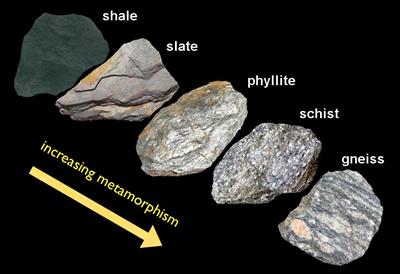PDF chapter test TRY NOW
The word metamorphic is originally derived from the word ‘Meta-morpha’, which means “To change form”. These rocks are formed when there is a change in the temperature and pressure of the igneous and sedimentary rocks. Such change in temperature and pressure causes the complete alteration in the mineral composition and texture without any disintegration of the respective rocks. This process results in a new kind of rock different from the original parent rock.
If changes occur in the rocks due to the high temperature of the magmas, it is called Thermal metamorphism. If the changes occur in the rock are due to the high pressure, it is called Dynamic metamorphism.

Based on the parent rock from which it is formed, metamorphic rocks are divided into:
Meta Sedimentary Rocks: The sedimentary rocks are metamorphosed to form new rocks.
Example:
- Limestone changes into marble because of temperature changes.
- Shale changes into slate due to dynamic metamorphism.

Meta Igneous rocks: The metamorphic rocks are formed because of the changes in igneous rocks.
Example:
- Gneiss forms into granites due to pressure changes.
- Basalt is changed into slate because of temperature changes.
Characteristics:
- They are crystalline in nature.
- They are hardly porous in nature.
- They have alternate light and thick colour bands.
- They do not have fossils.
Reference:
https://images.app.goo.gl/Vu5qe3jPygbAcYHm8
https://images.app.goo.gl/4KEYRnLMBTzrmNnZ9
https://images.app.goo.gl/4KEYRnLMBTzrmNnZ9
